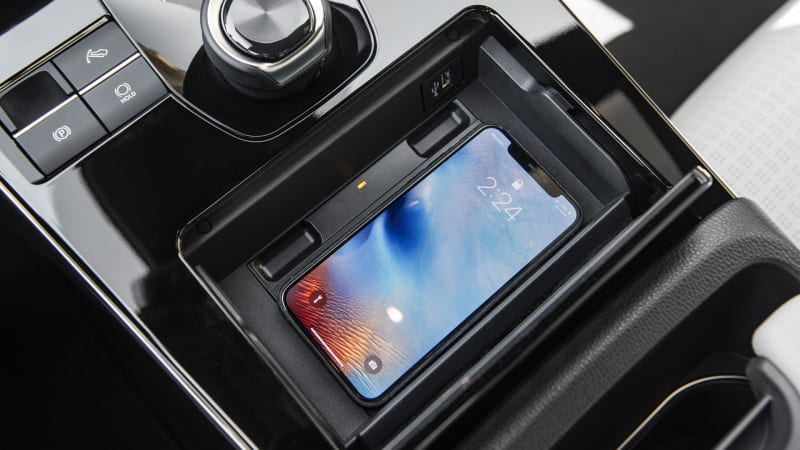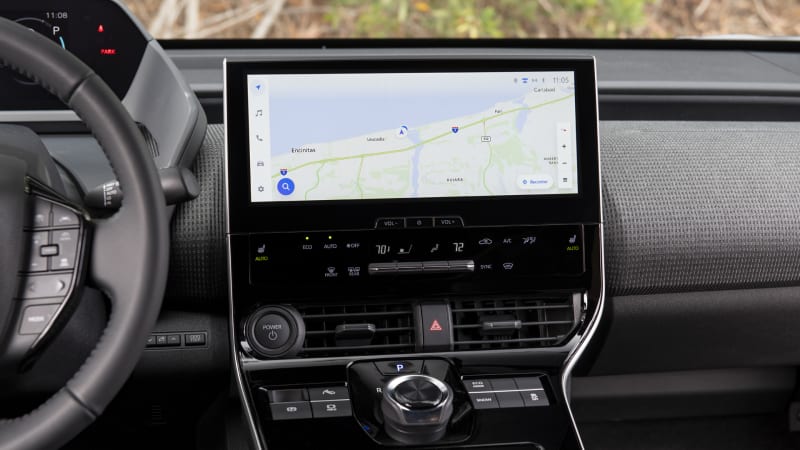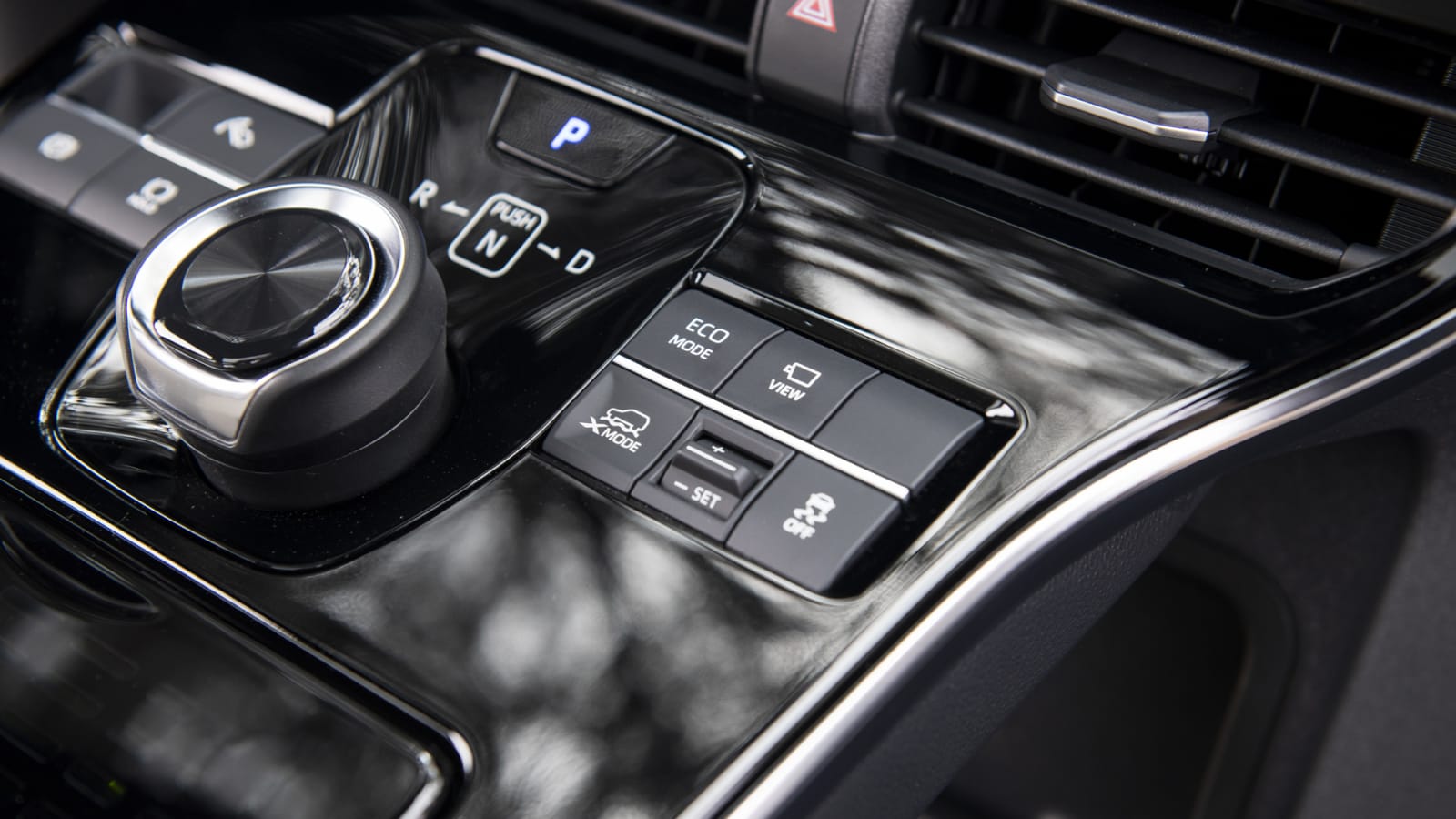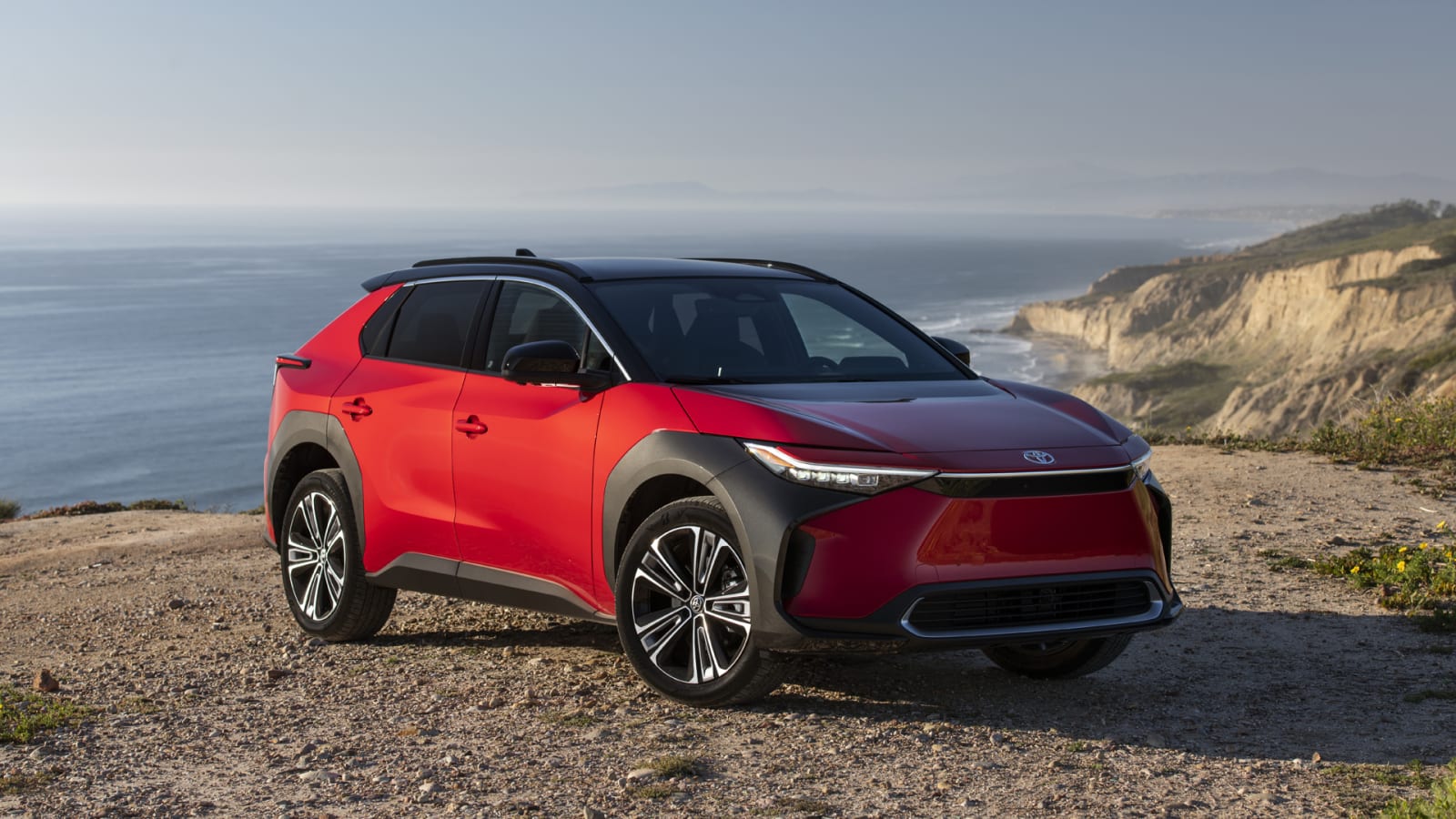Pros: Good value with FWD; a relatively conventional small SUV; high ground clearance for an EV; useful interior storage
Cons: Subpar range with AWD; slower to charge than some rivals; shine-in-your-eyes interior trim; hide-your-eyes styling
This may come as a surprise, but the 2023 Toyota bZ4X is the first from-scratch electric Toyota. And no, the handful of RAV4 EVs produced to please California regulators do not count. Turns out the company that popularized the hybrid has been hesitant to join the all-electric revolution. The bZ4X speaks to that hesitancy: it’s an exceedingly safe effort with RAV4-like styling, as well as range, power and recharging specs that are hardly ambitious. Toyota even split the development with Subaru, which calls its AWD-only version the Solterra. For those wishing Toyota still sold a RAV4 EV today, the bZ4X should probably satisfy. For everyone else, there are ultimately more compelling EVs.
At the same time, certain versions of the bZ4X present a strong value case. Specifically, the front-wheel-drive versions. You see, most other EVs like the Hyundai Ioniq 5, Kia EV6 and Volkswagen ID.4 come standard with a single motor powering the rear wheels. Their optional all-wheel-drive systems, which add a second motor for the front wheels, will be a must in wintery climates, but bring with them hefty performance and price increases. The AWD bZ4X instead swaps out its large front motor for a pair of smaller motors mounted one apiece to each axle – the performance upgrade is barely noticeable, but the price increase is roughly the same as what you’d find with gas-powered SUVs. Front-wheel drive is perfectly acceptable for winter, too, so you can easily bypass the AWD option altogether and enjoy more acceptable range (258 miles versus 228).
Basically, it’ll be easier for more people to live with a base-model bZ4X XLE than the similarly priced Ioniq 5, EV6 and ID.4. It’s a more competitive car when cheaper, and is equipped well enough that you shouldn’t feel shortchanged. Just don’t expect something as fully realized as the exceptional Ioniq 5 and EV6, nor even the characterful but flawed ID.4. Safe isn’t a terrible way to go (Toyota sold 400,000 RAV4s last year), but we wish Toyota had been more ambitious, at least with the powertrain.
Interior & Technology | Passenger & Cargo Space | Performance & Fuel Economy
What it’s like to drive | Pricing & Trim Levels | Crash Ratings & Safety Features
What’s new for 2023?
The bZ4X is an all-new model.
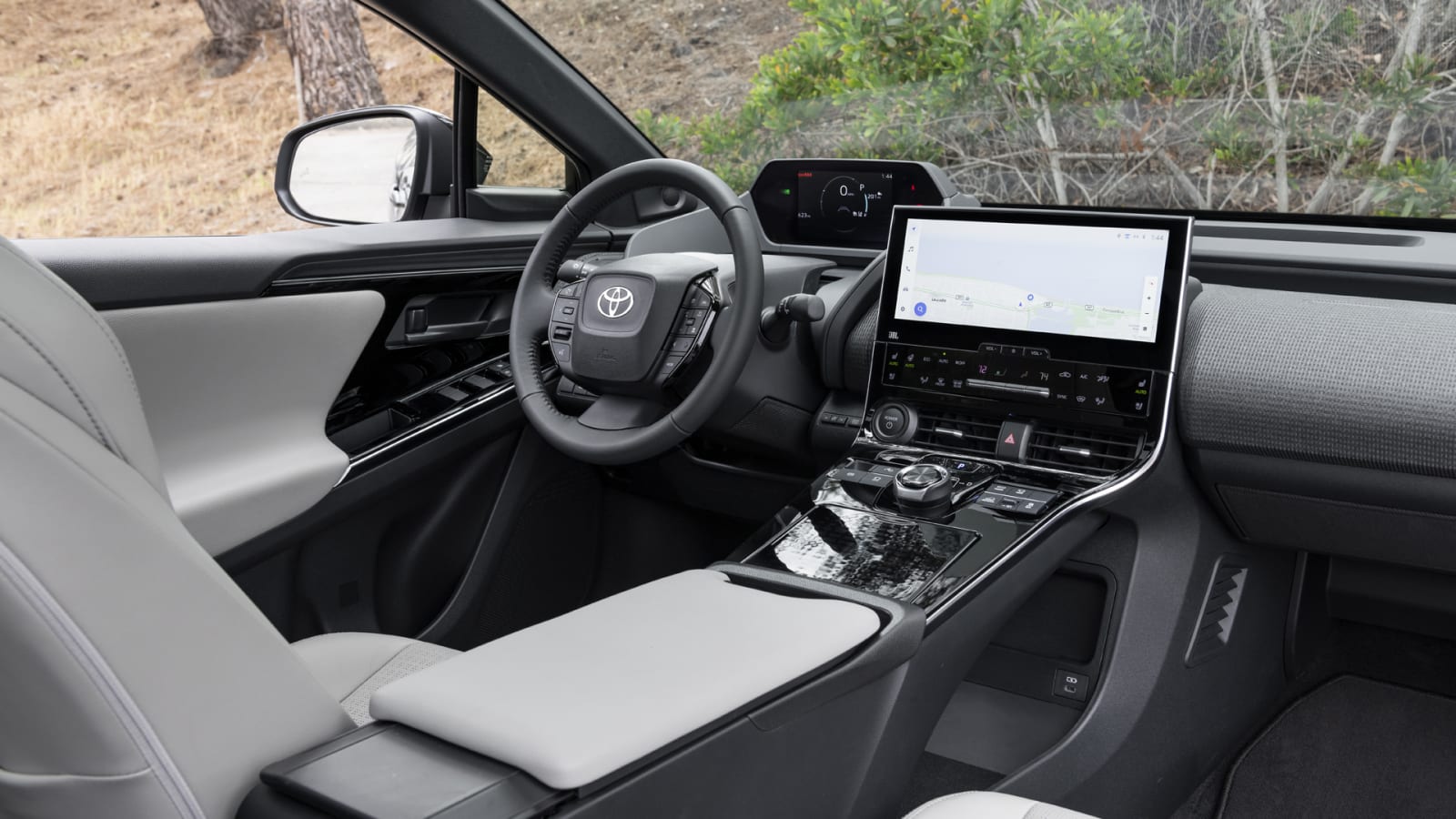
What are the bZ4X interior and in-car technology like?
The bZ4X strikes a nice balance between functionality and achieving the more futuristic aesthetic typically demanded of an EV. Basically, it’s not too weird. There are physical toggles for temperature settings and the accompanying touch-sensitive climate buttons are illuminated and seemed responsive enough during our first drive (that said, we’d prefer a volume knob). The shifter is yet another new-fangled design that’s different for different’s sake, but was also easy enough to figure out. More basic vehicle functions are still served by buttons and stalks. We also like the abundance of storage up front, including an enclosed bin for your smartphone.
Unfortunately, that bin’s cover and the surrounding trim are gloss black, which horribly attracts fingerprints and managed to consistently reflect the sun into our eyes while driving. The gray fabric on the dash is a much more successful and glare-free interior adornment.
In-car technology is dominated by a standard 12.3-inch touchscreen, which is Toyota’s latest interface shared only with the Tundra. It’s a clear upgrade over what you’d find in other Toyotas, and is generally user friendly. However, we would like a split-screen functionality, like Toyota offers with the Highlander’s widescreen display. The bZ4X also features a unique digital instrument panel placed roughly in between where traditional gauges and a head-up display would be in your line of sight. This means it’s above the wheel rim rather than under it. Shorter drivers might find the rim blocks some of the display’s bottom, but taller drivers should be fine. Toyota will apparently offer a Tesla-like yoke to remedy this, but that seems like a silly work-around “solution” to a problem that doesn’t need to exist.
How big is the bZ4X?
The bZ4X is about 4 inches longer and 2 inches lower than a RAV4, with 2.5 fewer inches of legroom, but that still makes it a compact SUV – just a slightly smaller one, not unlike a Mazda CX-5. It may be less able to fit a rear-facing child seat without scooting a front seat forward as a result of this.
Cargo space is also restricted compared to conventional compact SUVs because of its fastback roofline. It’s actually not unlike the Toyota Prius in its cargo area design, though it’s certainly larger. Its 27.7 cubic-feet is actually the same as the Kia EV6, and given the similar shape, should probably be able to carry as much stuff as the Kia can.
What are the bZ4X range and performance specs?
The front-wheel-drive bZ4X comes with a 150-kilowatt motor that produces 201 horsepower (about the same as the RAV4 Hybrid, though that weighs more than 500 pounds less). It has a 71.4-kilowatt-hour battery that returns an estimated 252 miles of range with the XLE trim and 242 with the Limited.
The all-wheel-drive bZ4X has a pair of 80-kW motors, one for each axle. Together they produce 214 hp – most all-wheel-drive electric vehicles have a substantial performance advantage over their two-wheel-drive versions. The advantage here is a much lower price. Although the AWD bZ4X battery has a similar capacity at 72.8 kW, it’s actually a different piece of hardware, and gets notably worse range at 228 miles with the XLE and 222 miles with the Limited. These mirror the AWD-only Subaru Solterra.
What’s the bZ4X like to drive?
The main difference between the FWD and AWD bZ4X is good old-fashioned torque steer. Gun the FWD model mid-turn and the bZ4X goes all Saab Turbo on you, wrenching the tiny steering wheel in your hands as 196 pound-feet of torque instantly pours through the front wheels. With AWD, it’s drama-free. Ditto if you just go easy on the accelerator.
Once up to speed, you’d be hard-pressed to tell the difference. The bZ4X basically feels like a more substantial RAV4, the result of being 576 pounds heavier than a comparable RAV4 Hybrid with all that extra battery weight distributed evenly down low between a longer wheelbase as opposed to being spread out all over the place with an engine, transmission, battery, gas tank, etc. And before you scoff, remember that the latest RAV4 is actually a surprisingly pleasing little SUV to drive, with precise and nicely weighted steering paired with a suspension that maintains its composure if hustled. So be the bZ4X. It’s not as engaging as the RAV4 Hybrid’s SE trim levels, though (including the RAV4 Prime), and you definitely shouldn’t expect the sort of fun-to-drive experience you’ll get in the Ioniq 5, EV6 or ID.4. Still, as a commuter, it’s better to drive than most and benefits from a well-executed one-pedal drive mode (its button is pictured above, bottom left) that should do most of the braking for you around town and in traffic.
Now, should you want to get the bZ4X dirty, the all-wheel-drive version includes Subaru’s X-Mode off-road-specific drive mode (pictured above, bottom right) that changes various vehicle systems to maximize traction. Its ground clearance is also much greater than all those other electric crossovers, though that goes for the FWD version, too.
What other Toyota bZ4X reviews can I read?
2023 Toyota bZ4X First Drive Review
In this review, we dig deeper into its design and engineering, plus what’s the deal with that name?
What is the 2023 bZ4X price?
Pricing for the bZ4X is pretty simple. The XLE trim level starts at $43,215; the Limited starts at $47,915. Add $2,080 for all-wheel drive. The bZ4X is currently eligible for a $7,500 federal tax credit, plus potential state-level tax credits or direct rebates.
As mentioned above, we think the bZ4X is most competitive with front-wheel drive due to its reasonable price, greater range and sufficient winter-weather traction (compared to RWD rivals). The XLE trim is also very well-equipped – we’d really only miss the Limited’s power front seats. You can also add a Weather package to it that adds heated front seats and a heated steering wheel.
What are the bZ4X safety ratings and driver assistance features?
Every bZ4X includes a forward collision warning and automatic emergency braking system with pedestrian, cyclist, motorcycle (daytime) and guardrail detection. Also standard are lane-keeping assist, blind-spot warning and Safe Exist Assist, which uses the blind-spot warning sensors to alert occupants to approaching cars from the rear.
The bZ4X has not been crash tested by a third party.
Related Video:
Source: www.autoblog.com


